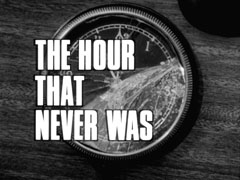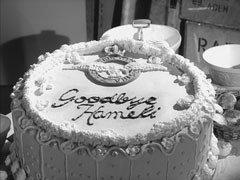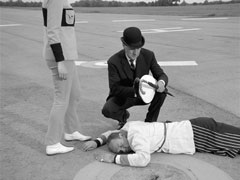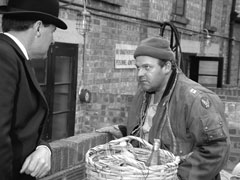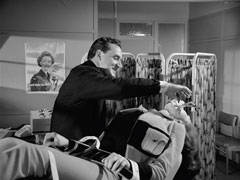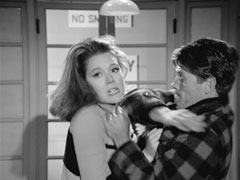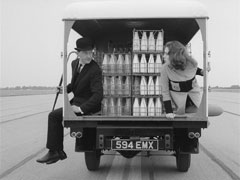Series 4 — Episode 9
The Hour that Never Was
by Roger Marshall
Directed by Gerry O’Hara
Read the dialogue sheets (PDF 490KB)
Read the original synopsis (PDF 118KB)
Production No E.64.10.14
Production completed: July 20 1965. First transmission: November 23 1965.
Production
Production dates: 5 — 20/07/1965
Roger Marshall’s draft script, entitled An Hour to Spare was received by Programme Manager Brian Tesler on 21 May 1965. A week later he replied, declaring it an intriguing and exciting scipt. A second draft atht end of June was approved once some amendments were made.
Filming started under Gerry O’Hara’s direction on 5 July even though script amendments kept coming in until 15 July. O’Hara’s team made full use of the fine weather and there was extensive location filming done at RAF Bovingdon and Tykes Water Lake for the episode. Some of the script amendments were due to what the discovered on location — the Mosquito bomber was written in for the rabbit sequence, and the cookhouse scene was changed to include the view in through the window. Patrick Macnee evene managed to add a call-out to his wartime commander, Bussy Carr, in the final production, probably as an ad-lib rather than an official script change.
Roger Marshall had wanted World War II songs like “We’ll Meet Again” and “Roll Out the Barrel” used in the episode but the rights proved too costly.
Filming wrapped on 20 July and the episode was considered done, and sent to the editing suite for completion. However, when Brian Tesler saw a finished print he was horrified by the sped up ending, thinking the slapstick comedy cheapened and ruined an excellent story (he was right). Brian Clemens disagreed, presenting a fourfold argument: the tag was a continuation of the lighter vein introduced by the laughing gas scene, and relieved the tension of the mystery suspense of the rest of the story; the tag should be considered separate; the tag scenes had become a show theme — light-heartedly having the heroes driving off to brighter horizons; and it was in line with The Man from UNCLE which had a similar concept. He probably ought to have argued that over-cranked footage was popular and pointed at the films from The Beatles and The Dave Clarke Five, as well as many other popular mid-Sixties comedies which utilised the technique. Tesler was not convinced, complaining that they has used it in Room without a View as well. (It was also used in The Gravediggers and Dial a Deadly Number).
Tesler had also demanded the title be changed and it was renamed “Roger and Out” which he also disliked and requested that they rename it again, hopefully working the puzzle aspect into the title; in the end he accepted the title “The Hour that Never Was” without comment.
Regional broadcasts
| Broadcaster | Date | Time |
|---|---|---|
| Rediffusion London | 26/11/1965 | 8:00pm |
| ABC Midlands | 27/11/1965 | 9:05pm |
| ABC North | 27/11/1965 | 9:05pm |
| Anglia Television | 25/11/1965 | 8:00pm |
| Border Television | 28/11/1965 | 9:35pm |
| Channel Television | 27/11/1965 | 9:05pm |
| Grampian Television | 27/11/1965 | 8:00pm |
| Southern Television | 27/11/1965 | 9:05pm |
| Scottish Television | 23/11/1965 | 8:00pm |
| Tyne Tees Television | 27/11/1965 | 9:05pm |
| Ulster Television | 26/11/1965 | 8:00pm |
| Westward Television | 27/11/1965 | 9:05pm |
| Television Wales & West | 27/11/1965 | 9:05pm |
TV Times listing
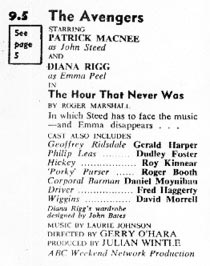
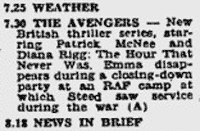
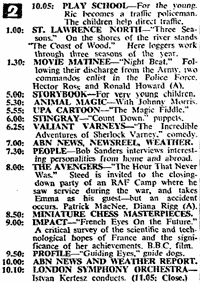
9.5 The Avengers
starring
Patrick Macnee
as John Steed
and
Diana Rigg
as Emma Peel
in
The Hour That Never Was
By Roger Marshall
In which Steed has to face the music — and Emma disappears …
Cast also includes
| Geoffrey Ridsdale | Gerald Harper |
| Philip Leas | Dudley Foster |
| Hickey | Roy Kinnear |
| ‘Porky’ Purser | Roger Booth |
| Corporal Barman | Daniel Moynihan |
| Driver | Fred Haggerty |
| Wiggins | David Morrell |
Diana Rigg’s wardrobe designed by John Bates
Music by Laurie Johnson
Directed by Gerry O’Hara
Produced by Julian Wintle
ABC Weekend Network Production
International broadcasts
| Broadcaster | Date | Time |
|---|---|---|
| ABN2 Sydney, Australia | 24/05/1966 | 8:00pm |
| ABV2 Melbourne, Australia | 17/05/1966 | 7:30pm |
| ABC New York, USA | 25/04/1966 | 10:00pm |
| ORTF2 France | 11/07/1967 | 8:05pm |
| Suisse Romande, Switzerland | 25/02/1967 | 9:10pm |
| French title | L’heure perdue | |
| ZDF Germany | ||
| German title | Die Fehlende Stunde | |
| KRO Netherlands | 7/03/1967 | 8:55pm |
| Dutch title | Het verdwenen uur / Het uur dat niet bestond | |
| Italy | 30/11/80 C51 | |
| Italian title | Il tempo si è fermato | |
| Spain | 19/06/1967 | 4:05pm |
| Spanish title | La hora que nunca llegó / La hora que nunca existió | |
Italy did not show this episode in the 1960s, the Italian titles are from the Tele Torino International broadcast in the 1980s, and DVD releases. German contemporary broadcasts did not include this episode.
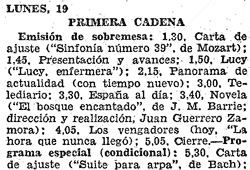

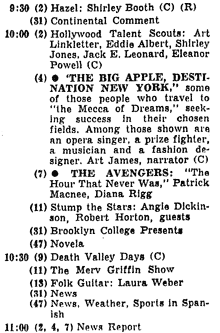
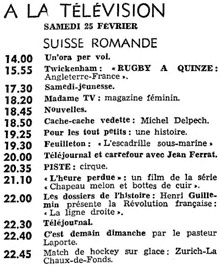
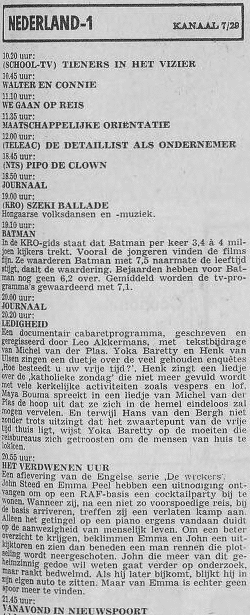
Episode Rating
| Subject | 0–5 |
|---|---|
| Direction | 4 stars |
| Music | 4 stars |
| Humour | 3½ stars |
| Intros/tags | 3½ stars |
| Villains | 4 stars |
| Plot | 4 stars |
| Emma | 3 stars |
| Sets/Props | 3 stars |
| Overall (0–10) |
8 stars |
Ripping stuff, with the foreign agents (Dudley Foster, villainous as ever) planting sleepers in every British base in the world. A fine performance from Roy Kinnear and a lovely noir feel to the episode.
The Fashions
| Emma’s Fashions | Steed’s Fashions |
|---|---|
|
|
The Cars
| Marque/Model/Type | Number Plate |
|---|---|
| Bentley | XR 6056 |
| Commer QX Signal Truck | 78 AE 73 |
| Hillman Super Minx Mark II convertible 1962 | 3850 VC |
| Hillman Minx | PCJ 374C? |
| Ford Consul 315 1961–3 | - |
| bicycles | - |
| Land-Rover Rescue Vehicle | - |
| Scammell Fire Tender | 31 AD 59 |
| Austin A55 Cambridge | 489 ALY |
| Scammell Fire Tender | 25 AG 08 |
| Alvis Mk.VIb Fire Tender | 03 AG 38 |
| Austin A99 Westminster | - |
| Aircraft Crash Rescue Truck (LWB Land-Rover chassis) | - |
| Mosquito | - |
| Bedford S Type truck | 99 AF 35 |
| Tip truck | - |
| AEC truck | .1 AG 48 |
| Wales & Edwards Milk Float | 594 EMX |
Who’s Killing Whom?
| Victim | Killer | Method |
|---|---|---|
| Milkman | ? V* | shot |
| Hickey | ? V* | shot? strangled? (off camera) |

Continuity and trivia
- 1:10 — the opening scene of river is Tyke’s Water Lake (they cross the bridge later, on the way into camp), the same location as the punting scene at the beginning of Silent Dust.
- 1:57 — that’s not Macnee and Rigg in the car in the long shots before the crash.
- 2:13 — to make the Bentley look like it’s crashed, they just pulled the bonnet off the engine and propped it up, loosened the spare tyre, pumped some smoke through the engine bay and spun the wheels. Much better than damaging a vintage car! It looks like the broken glass is achieved with cellophane.
- 4:05 — location filming for the road towards the camp was once again at Tyke’s Water Lake and bridge.
- 4:58 — Steed speaks of “returning from a mission, hunched over the controls, eyes red and rimmed with fatigue, the men groaning in the back”. Emma asks if he’d been to the Ruhr and he replies, “No, the local pub”.
- 5:53 — RAF Station 472 Hamelin was a launch-pad for agents during the war and was HQ for 472 Squadron.
- 6:05 — You can just see a car driving across the road in the airbase in the longshot from the runway but nothing should be moving.
- 6:21 — Emma quips, “Sic friat crustulum” as Steed talks about the base closing down. Steed looks at her quizzically and she translates, “That’s the way the cookie crumbles”. “The Latin cookie”, he replies. This exchange is something that would have been more likely in the higher-brow Cathy Gale days, but we get the occasional smattering of (sometimes tortured) Latin in the Emma Peel years.
- 8:01 — the Hamelin Air Base honour board near the door was also in he Town of No Return with the heading "33rd Squadron R.A.F.". All the officers names below are exactly the same.
- 9:46 — a guide wire for the cameraman is hastily pulled out of view in the bottom left corner of the screen.
- 11:14 — according to the packing crates, the cook has been reposted to RAF Air Base 69 Aden.
- 14:20 — according to his packing crates, Squadron Leader Geoffrey Risdale has been reposted to RAF Airbase 931 Singapore.
- 15:07 — Geoffrey Risdale is played by Gerald Harper, who became the star of the BBC’s attempt to copy “The Avengers”, “Adam Adamant Lives!” in 1966.
- 16:47 — vehicle & editing continuity: when Emma and Steed walked past the rescue vehicles, they pass an Alvis tender, Scammell tender and then turn to go alongside the Land-Rover. In the longshot from the top of the control tower, the Scammell has moved to the near side of the Alvis, so they would have had to pass that first.
- 17:21 — that’s not a rifle shot, the FX is a pistol bullet ricochet, and one of the most over-used FX in the business.
- 17:41 — the punk band “The Dead Milkmen” supposedly took their name from Ray Austin’s appearance as the milkman killed in this episode.
- 19:48 — an obvious over-dub of Mrs. Peel saying “Steed” as they run across the taxiway — but it’s not Diana Rigg’s voice!
- 25:30 — When Steed throws his drink in frustration, half of it ends up on his left shoulder.
- 26:40 — Hickey lists Biggin Hill, Mildenhall and Cardington -all real RAF air bases — as well as Hamelin as his regular haunts.
- 33:50 — David Morrell, who has a brief appearance as an RAF officer, went on to be a best-selling author of thriller novels. His film career was mostly rôles like this — (he’s watching his friend play pinball and greets Steed enthusiastically).
- 35:18 — Geoffrey Ridsdale DFC’s medals are all pinned upside down and therefore back to front — perhaps intentionally to indicate something is wrong or as a red herring. They are:
Distinguished Flying Cross, General Service Medal, 1939 to 1945 Star, Air Crew Europe Star, Defence Medal, War Medal 1939-45.
Wing Commander Davies in Man-eater of Surrey Green has the same medals, the top row also upside down but the bottom row are pinned the right way round. - 36:50 — Geoffrey tells Steed that they’re all being scattered to different parts of the world — Porky is going to Aden, (along with the cook) and Wiggins is going to Berlin.
- The transcript of the episode reveals that Cliff Diggin’s character is called Glover. The cook’s name is Sergeant Henderson, according to Steed’s story about the cake but in the draft script it was Sergeant Davidson.
- 43:32 — there’s a hair on the camera lens near top left, it remains until 44:38 when the vision switches to Emma at the window.
- 43:37 — more bondage for Mrs. Peel, this time she’s been strapped to the dentist’s chair.
- 44:00 — Mrs. Peel declares that she’s found ampules of “C.11, a derivative of the truth drug used in brainwashing”.
- 44:23 — Mrs. Peel incorrectly refers to “nitreous oxide” for the laughing gas, N2O, which is of course nitrous oxide.
- 48:21 — Billy Westley Jr does the backwards leap as Emma is thrown by Cliff Diggins but up till then Cliff has been grappling with Diana Rigg, the lucky man.
- 48:29 — the footage is sped up as Emma and Steed chase after the milk float, à la The Beatles or The Dave Clarke Five in their films of the same year.
- Running time: 49′40″
- Roger Marshall wanted Vera Lynn’s “We’ll Meet Again” playing over the RAF sequences but the rights were too expensive.
Where I have listed two sets of timecodes, the first is from the 2009–11 Optimum Releasing/Studio Canal DVD sets, any other timecodes are from the A&E and Contender DVD sets from a decade beforehand.
The new releases have been remastered and their frame rate has been changed, resulting in a shorter running time. However, the picture quality has increased markedly. I assume this is because they used a simple 2:2 pulldown (24 @ 25) when converting from the original film masters (film runs at 24 frames per second, while PAL runs at 25fps, the new DVDs are in PAL format).
This pulldown was also the cause of audio errors on many episodes, especially for Series 5, as the audio sped up to match the new rate (4% faster), rather than being properly pitch-shifted. Checking the dialogue sheets, which list the feet and frames of the reels, it looks like the speed change is around 5.04%, so there may be some cuts as well - probably from around the commercial breaks and ends of reels, as they amount to about 25 seconds. All my assumptions are based on the episodes having been filmed on standard 35mm film, which has 16 frames per foot and runs at 24 frames per second, so a minute of footage uses 90 feet of film (1,440 frames).
These audio errors have been corrected in the currently available DVDs, but the 2:2 pulldown remains. There is also the addition of a Studio Canal lead-in, converted to black and white to match the episode for Series Four, but colour for Series Five, adding an extra 18 or 19 seconds to the runnning time and making it harder to match timecodes with previous releases. It’s annoying that it has been slapped on every single episode, Series 1–3 didn’t suffer this indignity.
The previous Contender and A&E DVD releases didn’t seem to suffer from these problems, so I assume they either used soft telecine and preserved the original 24fps rate of the film (my preferred option in DVDs) or they used 24 @ 25 pulldown (2:2:2:2:2:2:2:2:2:2:2:3 Euro pull-down).
Thankfully, the new blu ray releases for series 4–6 appear to use native 24fps with soft telecine so the running times and pitch all seem to be correct again along with a much grreatly improved picture quality, most notably in the Tara King episodes which are finally back to their original glory.
